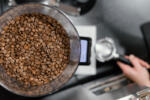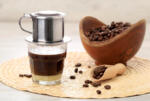Are you a coffee lover looking for a new way to get your caffeine fix? If so, then cappuccino is the perfect beverage for you! This blog post will show you how to make the perfect cappuccino with just a few simple steps.
The Essentials from Frothed Milk to Syrupy Espresso
As coffee shops have become increasingly popular across the country, from Seattle to the small town, so has the famed espresso beverage, the cappuccino. While it can be a pleasure to go out for a well-made cappuccino, it can become an expensive daily habit.

Recently, manufacturers like Krups and Illy have made quality espresso machines affordable for individual use. Today, anyone can make the perfect cappuccino at home.
Fresh Coffee Beans
Making the perfect cappuccino starts with grinding and measuring fresh coffee beans. The right type of coffee can make a huge difference in the flavor and aroma of your beverage. The best way to get the most out of your beans is to grind them before brewing. This will ensure that you extract your coffee’s fullest flavor and aroma. When selecting your beans, look for freshly roasted and properly stored ones.
Preheat Your Cup
Preheating your cup is an important step in making the perfect cappuccino. Preheating your cup ensures that the temperature of the coffee won’t be affected by a cold cup. This helps maintain the ideal temperature for brewing espresso and creating silky foam with a steam wand.
A pre-warmed espresso cup can be achieved by running hot water through it or using a cup warmer on top of the machine. Preheating your cups helps keep coffee at its optimal temperature and prevents coffee from cooling too quickly.
Frothing the Milk

The first component of the perfect cappuccino is creamy, well-frothed milk. While a latte is made from espresso and steamed milk and is considered wet, a cappuccino is espresso and milk foam and is considered dry. The consistency should be light and airy, easily shaped with a spoon.
The most ideal milk to make perfect foam is cold skim milk. Whole milk or cream will not froth as easily because of their weight. Cold milk will work better than warm or room-temperature milk. You can add an ice cube to the milk to reduce the temperature.
Pour milk fresh from the refrigerator into a stainless steel pitcher, preferably cold. Fill the pitcher less than half full to leave room for the foam. Place the steam wand into the milk at a 90-degree angle, as close to the center of the container as possible. Start by touching the head of the wand to the bottom of the pitcher. Turn on the wand to its full strength, using as much air pressure as possible.
Once the milk begins to rise, after ten to thirty seconds, bring the pitcher down so that the wand head is just under the surface. The key at this point is sound. If the steam wand makes a screeching or hissing sound, and the milk is upset and bubbling, the wand isn’t deep enough within the milk. Raise the pitcher slightly until the steam wand makes a smooth humming sound while the milk steadily rises into a creamy, airy foam.
The proper foam should be 160 degrees Fahrenheit. If you don’t have a kitchen thermometer, a good rule of thumb is when the side of the metal pitcher is too hot to touch, the milk is ready.
Pulling the Perfect Espresso Shot
Once the milk is ready, it is time to make the espresso. This should always be the final step because the flavor of espresso deteriorates as it is exposed to oxygen. First, use a finely ground espresso roast. It should be powdery in consistency. Although your coffee shop can grind the beans for you, freshly ground espresso beans will yield a much better-tasting espresso.
Next, put just enough ground espresso into the portafilter to reach the top. Level off any excess grinds with the flat edge of a knife. The espresso now needs to be pressed down or tamped. This is because the espresso must be extremely tight and nonporous so that when the pressurized hot water travels through the grounds, it can take the highest amount of coffee essences with it.
Tamp the espresso lightly, with about five pounds of weight, then a second time with more force, about thirty pounds. Put the portafilter into the espresso machine, and pull the shot. With most machines, this involves pressing a button to start the water.
Time your shot. It should take between 18 and 25 seconds for the espresso the extract. The liquid should be rich and syrupy, darr, with a light brown layer of crema on top, and beautifully aromatic.
Once the shot has been pulled, you can either pour the espresso over your cup of a frothed mil or vice versa. Use a spatula when pouring the milk to control the amount of liquid you prefer versus the amount of foam. You now have a perfect cup of cappuccino.
Add Flavoring To Taste
Adding flavoring to your cappuccino can take your morning cup of joe to the next level. There are many different types of flavorings that you can use, ranging from sweet to savory. You can find these flavorings at most grocery stores or online.
Some popular flavors include chocolate, caramel, hazelnut, and vanilla. Adding a few drops of these flavorings into your cappuccino while it is still hot will give you an amazing cup of coffee with added depth and complexity. Experiment with different combinations and amounts until you find the perfect balance for your taste buds!
Clean Up After Making A Cappuccino
Making the perfect cappuccino requires the right equipment, technique, and ingredients. Cleaning up after making a cappuccino is just as important. To ensure that your coffee tastes great and lasts longer, follow these steps to clean up after making a cappuccino:
- Turn off the frother after use and disconnect it from the power source.
- Swirl any remaining milk in the frother around in circles for about 30 seconds to remove any excess foam or milk residue before washing it out with hot water.
- For espresso machines such as the Breville Barista Express, cleaning and equipment maintenance is an essential part of keeping your coffee tasting great for a long time. After use, rinse out the portafilter with clean water before reinserting it into its proper place on the machine.
- For DeLonghi 15 Bar Espresso and Cappuccino Machines, rinse out any remaining acidic coffee that’s left in the machine with water before attempting to brew another cup of coffee or latte art.
- Cleaning Aeroccino Milk Frother jugs is easy – just run warm water over them
Conclusion
Conclusion: Making the perfect cappuccino is a skill that requires practice, patience, and the right ingredients. The key to making a great cappuccino lies in creating the perfect balance between espresso, milk, and foam. Using high-quality coffee beans, whole milk with a high fat content and an appropriate frothing technique will help you craft an amazing cappuccino every time!

Editorial Staff
The editorial staff at Crazy Coffee Crave is a team of coffee enthusiasts & Baristas who enjoy the one thing we all think about as soon as we get up in the morning. Trusted by thousands of readers worldwide.





